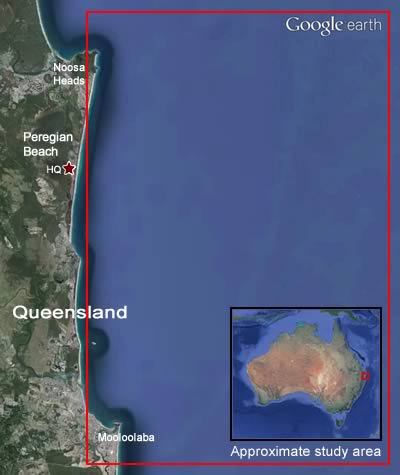BRAHSS Project Methodology


We conduct experiments in which humpback whales migrating along Australian coasts are exposed to a full commercial air gun array and to some components of ramp-up, while we observe the reactions of the whales and measure a wide range of variables likely to affect the reactions. Exposure to components of ramp-up will be done at a near shore site on the east coast where a high resolution observations are possible with shore based observations. Exposure to a full seismic array will be done at an offshore site off the west coast. Aspects of the east coast experiments will be repeated off the west coast to compare the reactions of the two populations.
Observations will include
All experiments will include controls in which the air gun vessel is towing the air guns but they are not firing, and controls in which the vessel is absent. All focal group observations follow a “before, during, after” design and so each group also acts as its own control. The sound field across the sites during experiments will be determined by multiple spaced measurements of received levels, propagation loss measurements and modelling. The observed behavioural changes at the sites will be compared with the extensive knowledge of normal behaviour and its function, and reactions to other stimuli available from previous studies at these sites. These comparisons will be used to infer effects of
The results will be analysed by developing generalized linear mixed models in which the contributions of the variables measured to the whale reactions can be determined.
Scientific Significance of the Project
This project will build on previous studies of the effects seismic activity on whales and extend them in a number of areas. The logistic difficulty of studying whales limits the
The experimental procedures to deal with these difficulties have developed in previous experiments over the last 25 years, and the results of these experiments have led to
This project is a continuation of those studies that preceded it. The previous work will be augmented by combining the following:
- The proposed project will combine Behavioural Response Studies (BRS) (also known as Controlled Exposure Experiments) using a commercial seismic array and BRS using individual stages of the ramp-up procedure used in seismic surveys (single air gun, four air guns etc.) to determine whale reactions to a wide range of exposures. It will assess whether ramp-up is effective as a mitigation measure.
- Multiple scales of observation will provide significantly greater resolution and detail of behavioural data than most previous experiments.
- It will go beyond a simple
dose response study where thedose related only to the received noise and test the contribution of a wide range of variables likely to affect reactions toair gun arrays. It will provide the range in the values of these variables needed to do this and to avoidpseudo replication , the failure of the experimental design to provide sufficient variety in the samples taken to obtain arepresentative of the type of stimulus, the subject or other variables that affect the result. - Variables will be measured over a range of values and multivariate statistical methods such as generalized linear mixed model will be used to tease out the contributions of the different variables, thus making the results generally applicable to humpback whales exhibiting similar behaviour elsewhere.
Statistical power analysis has been used to ensure that the planned sample size is adequate to obtain statistically significant results and this analysis will be repeated for each subsequent experiment using data from the previous one. - The reactions will be placed in the context of normal behaviour and reactions to other stimuli that may be encountered by the whales using the unusually large amount of data on normal behaviour and biology that exists for the populations studied. This will allow us to make progress in making inferences and developing models relating observations to effects to life functions.
